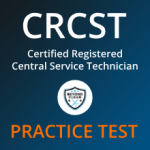Training to be a sterile processing technician means you’ll get quality education in decontaminating, sterilizing, and organizing medical tools critical for procedures and surgeries.
However, as one of the entry-level positions in the healthcare industry, is the price of education worth the salary potential in the long run?
Throughout this article, we’ll help you learn more about the costs of becoming a sterile processing tech, as well as how to find the best value for whatever education route you take.
Understanding Cost vs. Value of Sterile Processing Technician Training
It’s short-sighted to approach the cost of sterile processing technician training by looking for the least expensive option.
No two programs are the same.
Some include extensive learning on various topics, while others are designed to just pass the certification exam.
Avoid treating “less expensive” as “the best value.”
On the other hand, the highest tuition doesn’t always mean the best education.
Here are some things to consider:
- Accreditation: Ensure the program is accredited by recognized organizations such as the Healthcare Sterile Processing Association (HSPA). Accredited programs work you toward getting the certification most healthcare systems will require.
- Certification Preparation: A valuable program will prepare students for certification exams like the Certified Registered Central Service Technician (CRCST). Check if exam fees and reference materials are included in the tuition. This could save you more than $200.
- Hands-On Training: Look for programs that offer clinical or practical hands-on training in real-world settings as part of the curriculum. For the CRCST, you’ll need 400 hours of hands-on training, even if you pass the exam.
- Program Length and Flexibility: In-person classes will generally cost more than virtual or hybrid courses. Plus, you might be able to focus better with a course you can complete at home. Choose the education path that will give you the greatest chance to succeed.
Good value programs often offer financial aid, scholarships, or payment plans, making them more accessible without compromising on quality.
You can also consider applying for a scholarship to lower your financial obligation.
Overview of Costs to Complete Sterile Processing Technician Education
The majority of sterile processing technicians won’t get a four-year degree.
Most sterile processing techs complete a short certificate or associate program since a bachelor’s degree is more education and cost than needed for the job.
Entry-Level Jobs
First, high school graduates or those with GEDs can enter the sterile processing workforce, provided there’s a role available that accepts minimum experience and is willing to train on the job.
In this case, the cost is minimal.
A few things I would recommend include becoming a member of the Healthcare Sterile Processing Association, which is about $60 a year if you are taking the certification or re-certification exam.
Also, the most recent version of the Sterile Processing Technical Manual is the “Bible” of this business.
That will cost less than $100 per edition.
Certification Courses, Trade School or Community College
Nationwide, many online courses, community colleges, and technical schools offer courses or an education path in sterile processing.
Costs vary from $500 to $5,000.
The HSPA works with Purdue University for an online self-study program that costs anywhere from $350 to $458.
If you have location tracking enabled on your search engine, looking for “Sterile Processing Technician Education Near Me” will show a list of top options in your city.
For example, I’m in Nebraska right now, and the cost is $780 for a six-week course at Nebraska Methodist College.
At Blackhawk Technical College, eight credits (two semesters) will cost around $1300 for a sterile processing technical degree.
However, it also puts you on a path to getting a surgical tech degree, which has an average salary that is 57% more.
At the same time, the cost of a degree in surgical technology is around $10,000.
How Much Does a Sterile Processing Technician Certification Cost?
Certification can be obtained through the Healthcare Sterile Processing Association (HSPA) and the Certification Board for Sterile Processing and Distribution (CBSPD).
Most sterile processing techs will go for one or the other, not both.
The HSPA certification costs $140.
The CBSPD exam fee is $128.
Re-certification is generally required every five years.
What Are the Additional Costs After Becoming a Sterile Processing Technician?
The only additional costs a sterile processing tech might incur involve comfortable and supportive shoes for long periods of standing, additional certification levels, or scrubs if the healthcare setting doesn’t provide them.
As a consensus, healthcare facilities will provide scrubs and launder them for the SPTs due to the importance of reducing contamination and maintaining a sterile environment.
For any internship or job interview, ask if the potential employer pays for the cost of scrubs.
As noted above, also factor in the annual memberships for organizations like the HSPA to stay on top of technology trends, career updates, and networking with other professionals.
Is Becoming a Sterile Processing Technician a Good Investment?
The education requirements are pretty unparalleled in the healthcare setting, as the potential exists to get hired right out of high school.
By comparison, becoming a nurse can cost an average of $61,000 and take much longer to get the proper education.
The bigger challenge is finding a healthcare setting with positive reviews from employees who also pay at or above the median wage.
There are some horror stories in subreddits about sterile processing that put hourly wages at $16.00 an hour.
When you look at that potential, spending extra money on certification goes a long way toward getting a more competitive salary.
Key Takeaway about the Cost of Becoming a Sterile Processing Tech
The most important aspect when considering the price tag of becoming a sterile processing tech is finding a program that fits your budget and provides the most opportunity for learning and hands-on education.
A six-week course with a low price tag might fit your timeline, but it could poise you to be near the bottom of the stack of qualified applicants when it comes time to hire.
Sources
- COST: https://www.cbspd.net/what-is-certification/
- COST: https://myhspa.org/certification/certification-overview/certified-registered-central-service-technician-crcst/
- Blackhawk: https://blackhawk.edu/Programs-Classes/Explore-Programs/Program-Detail/program/Surgical-Technology
- Nebraska Methodist: https://www.methodistcollege.edu/allied-health/certificates/sterile-processing-technician
This page is also available in Spanish.










